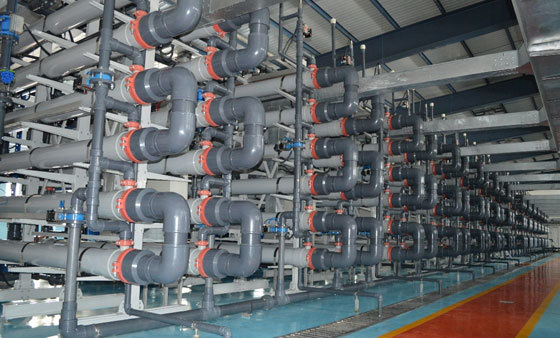 Esperanto
Esperanto
 Shqiptare
Shqiptare
 Euskara
Euskara
 Zulu
Zulu
 Latinus
Latinus
 Cymraeg
Cymraeg
 தமிழ்
தமிழ்
 Slovak
Slovak
 Slovak
Slovak
 Afrikaans
Afrikaans

Application
Oil Field
Release time: 2023-03-30
It mainly involves the treatment and reuse of oilfield oil production wastewater, and the treatment of oilfield fracturing fluid wastewater.
1. Re-injection technology for reducing salinity of polymer-containing wastewater in oilfields
With the deepening of oil production and development in oilfields, the consumption of low-salinity water for polymer flooding has increased significantly, and the cost of polymer injection has also increased. In addition, due to the massive injection of clean water in polymer flooding, it is also difficult to balance the reinjection of oily sewage. Therefore, the technology of preparing diluent polymers with the sewage produced by the oil field becomes more and more important.
Part of the oil field wastewater is used as re-injection water after treatment, and part is discharged outside. The discharge of oil production sewage is not only a waste of resources, but also seriously pollutes the environment. Therefore, the recycling of oil production sewage is an important measure to solve the deterioration of the ecological environment of the oil field and control the catastrophic changes of the groundwater system. In addition, providing qualified re-injection water to meet the water quality requirements of oilfield production is of great significance to ensuring high and stable oilfield production.
In the process of oil extraction, the sewage produced in the oil field not only contains a large amount of pollutants such as polymers (PAM), emulsified oil, and suspended solids, but also has the characteristics of high hardness and high salinity (>3000mg/L). Although ordinary PVDF tubular membranes have been widely used in the oilfield industry, their operating conditions, lifespan and flux are always criticized.The superior performance of PEK tubular membrane in removing oil and suspended solids can save a lot of clean water, and its superior alkali resistance can quickly restore the flux under strong alkaline cleaning conditions.

2. Oilfield fracturing fluid treatment technology
In recent years, oil exploration has turned its attention to unconventional oil and gas fields, whose matrix permeability is generally small and requires hydraulic fracturing to obtain production capacity. The development mode of unconventional oil and gas fields is dominated by horizontal wells. The fracturing operation scale and fluid volume are 5 to 10 times that of conventional oil and gas reservoirs. A large amount of fracturing fluid is injected into the formation during hydraulic fracturing.
After hydraulic fracturing, if the flow-back is not timely or the flow-back rate is low, part of the fracturing fluid will remain in the formation for a long time, causing damage to the formation. If there is a groundwater source near the target layer of the oil and gas reservoir, and the fracturing construction communicates with the groundwater layer, it will cause serious pollution to the groundwater source. There are many kinds of fracturing fluid additives, with complex components and high COD. The composition of different fracturing fluid systems is very different. If it is not handled properly, the pollutants in the fracturing flow-back fluid will seep into the groundwater, which will seriously affect the groundwater quality. In addition, due to rainwater scouring, the flow-back waste liquid may enter the river with the surface runoff, causing pollution to the surface water body. The fracturing flow-back fluid contains trace amounts of heavy metal elements, which are stable in performance and difficult to remove when they penetrate into the soil, and will not have a significant impact on surface water and vegetation in a short period of time. However, with the increase in the content of these elements in the soil, the soil fertility will decrease, which is not conducive to the growth of crops and vegetation, and has an impact on the environment. Various pollutant components in fracturing flow-back fluids may also affect terrestrial wildlife and indirectly harm human health.
The flow-back rate of fracturing fluid is closely related to the geological characteristics of oil and gas reservoirs. Affected by formation energy, the lowest flow-back rate is only about 10%. In the process of fracturing design optimization, it is one of the important problems to be solved in unconventional reservoir fracturing to optimize the fracturing fluid system according to different formation properties, improve the fracturing fluid's gel breaking performance, and promote fracturing fluid flow-back. . The implementation of fracturing fluid treatment and re-injection technology is of great significance.
There are many treatment methods for fracturing flow-back fluid, and chemical coagulation method and chemical oxidation method are commonly used as pretreatment. Although the purpose of reducing the COD value can be achieved, the introduction of a large number of chemical agents for a long time leads to higher and higher salinity and more and more difficult treatment. Therefore, the use of membrane technology (PEK tubular membrane + RO and other technologies) to promote fracturing fluid flow-back has a strong competitive advantage.
Recommended product
 Hefei-Anhui-China
Hefei-Anhui-China +8618226169015
+8618226169015 haoyangyu@plummembranes.com
haoyangyu@plummembranes.com







 haoyangyu@plummembranes.com
haoyangyu@plummembranes.com
 8618226169015
8618226169015
 Message
Message
